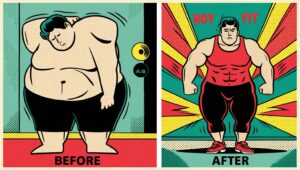Last Updated on August 7, 2024 by Alexander Sennuga
Discover “how I cured my insulin resistance” in this compelling personal journey, revealing my steps to regain control of my health.
From dietary changes and exercise routines to mindfulness practices, I delve into the holistic strategies that made a difference. Join me as I share actionable tips and insights to help you overcome insulin resistance and embrace a healthier life.
Let’s dive together!
What is insulin resistance?
Before we dive in, let’s talk about what insulin resistance is. It’s when your body’s cells don’t respond well to insulin, making it harder for your body to use glucose for energy. This can lead to all sorts of health problems, including diabetes if left unchecked.
Early Signs and Symptoms

Recognizing the issue
At first, I didn’t realize anything was wrong. I just felt a bit off, you know? But as time went on, I started noticing some changes that I couldn’t ignore.
My symptoms vs. common symptoms
For me, the big red flags were:
- Constant fatigue, even after a full night’s sleep
- Weird sugar cravings that wouldn’t go away
- Gaining weight despite not changing my diet
These are pretty common symptoms, but everyone’s experience can be a bit different. Some people might also notice:
- Increased thirst
- Frequent urination
- Darkened skin in certain areas (like the neck or armpits)
What steps did I take on this “how I cured insulin resistance” journey?
Consulting the Experts

The decision to see a doctor
After a few months of feeling not quite right, I decided it was time to see a doctor. I was nervous, but I knew it was the right call.
Tests and diagnosis
My doctor listened to my symptoms and ordered some blood tests. When the results returned, they confirmed what we suspected: insulin resistance. It was scary, but also a relief to have an answer.
My Treatment Plan

Diet adjustments
The first big change was my diet. I had to say goodbye to a lot of processed foods and hello to more whole foods. It wasn’t easy, but it made a huge difference.
Exercise routines
I also started moving more. Nothing crazy at first – just daily walks and some light strength training. As I got stronger, I added in more intense workouts.
Importance of sleep
One thing that surprised me was how much sleep mattered. Getting enough quality sleep became a top priority in my treatment plan.
What did I go through?
Challenges and Solutions

Dietary temptations
Let’s be real – changing your diet is tough. I missed my favorite treats, but I found healthier alternatives that satisfied my cravings.
Maintaining motivation
Some days were harder than others. I kept a journal to track my progress, which helped me stay motivated on tough days.
Managing stress
Stress can mess with your insulin levels, so I had to learn some stress management techniques. Meditation and deep breathing exercises became my go-to tools.
And then what?
Monitoring Progress

Monitoring progress can be crucial in achieving health goals and staying on track with lifestyle changes. To effectively monitor my progress, I used a combination of various tools and methods. These helped me maintain consistency, get accurate data, and make informed adjustments as needed.
1. A Food Diary App
I utilized a food diary app to log everything I ate and drank daily. This app provided me with insights into my eating habits, including caloric intake, macronutrient distribution, and any dietary patterns that needed adjustment. It served as both a motivational tool and an accountability partner.
– How it helped:
– Tracking calories and nutrients
– Identifying food-related trends or triggers
– Setting and monitoring dietary goals
2. A Fitness Tracker
To stay on top of my physical activity, I employed a fitness tracker. This wearable device measured my daily steps, exercise routines, heart rate, sleep patterns, and more. It provided real-time feedback and historical data analysis, allowing me to see how my activity levels correlated with my overall health improvements.
– How it helped:
– Keeping a record of daily physical activity
– Monitoring heart rate and sleep quality
– Setting and achieving fitness milestones
3. Regular Check-ins with My Doctor
Maintaining regular appointments with my doctor was a key component in tracking my health progress. These check-ins allowed for professional evaluation, ensuring that any health issues were identified and addressed promptly. My doctor provided tailored advice based on my tracked data and general health condition.
– How it helped:
– Professional medical evaluation and advice
– Adjusting health plans and medications as needed
– Early detection of potential health issues
Key Metrics to Track
To gauge my progress and make necessary adjustments, I focused on several key metrics. These metrics provide clear and measurable indicators of my health status:
1. Fasting Blood Glucose Levels
Monitoring my fasting blood glucose levels was essential for managing my blood sugar. Consistent tracking helped me understand how my diet, exercise, and other factors impacted my glucose levels, and inform any necessary lifestyle changes or medication adjustments.
– Importance:
– Indicator of immediate blood sugar control
– Identifying patterns related to food intake and activity levels
– Basis for diabetes management strategies
2. A1C Levels
A1C levels, representing my average blood glucose over the past two to three months, were another critical metric. Regular monitoring of A1C levels helped assess long-term blood sugar control and the effectiveness of my health management plan.
– Importance:
– Long-term indicator of blood sugar management
– Assesses risk for diabetes complications
– Evaluate the overall effectiveness of diabetes control strategies
3. Weight and Body Measurements
Tracking my weight and body measurements provided insight into my overall physical health and body composition changes. These metrics helped me understand how my diet and exercise habits were influencing my body, and in setting realistic fitness and health goals.
– Importance:
– Monitoring weight loss or gain trends
– Assessing changes in body composition (e.g., muscle vs. fat)
– Setting and evaluating fitness and health goals
By consistently using these tools and tracking these key metrics, I maintained a holistic and informed approach to my health. This multi-faceted monitoring system provided a comprehensive understanding of my progress and guided me toward optimal health outcomes.
So, what must I show for all these efforts and tell the story about how I cured my insulin resistance?
Visible Improvements

Physical Changes
Adopting new health habits and consistently monitoring progress led to several visible and noticeable physical changes over a few months. These changes not only boosted my confidence but also served as tangible proof of the efficacy of my efforts.
1. Clothing Fit Better
One of the most gratifying changes was noticing how my clothes fit better. This improvement wasn’t just about losing weight but was also about how my body reshaped and toned up.
– Details:
– Pants and skirts that were once tight now felt comfortable.
– Tops and jackets started to fit more comfortably around my shoulders and chest.
– I could wear clothes that had been sitting at the back of my closet.
2. Clearer Skin
Another significant change was the improvement in my skin’s appearance. Better food choices, hydration, and reduced stress played a big role in this transformation.
– Details:
– Fewer breakouts and blemishes
– Brighter and more even skin tone
– Increased radiance and reduced dryness or oiliness
3. Less Bloating
Modifying my diet and increasing my physical activity resulted in noticeably less bloating. My stomach felt flatter, and I was more comfortable throughout the day.
– Details:
– Reduced discomfort and abdominal distension
– Less frequent digestive issues, such as gas or indigestion
– Overall sense of lightness and well-being in the abdominal area
Energy Levels and Mood
While the physical changes were highly motivating, the improvement in my energy levels and mood was perhaps the most remarkable and life-changing aspect of my journey.
1. Increased Energy Levels
With the combination of a balanced diet, regular exercise, and better sleep, my energy levels significantly increased. I felt more vibrant and capable of handling daily tasks.
– Details:
– Waking up feeling refreshed rather than sluggish
– Sustained energy throughout the day without the usual afternoon slump
– Enhanced productivity and focus in both personal and professional life
2. Enhanced Mood
Improved physical health had a direct and profound effect on my mental health. My mood brightened, and I felt a renewed sense of joy and positivity.
– Details:
– Reduced feelings of anxiety and stress
– Enhanced ability to cope with challenges and setbacks
– Feeling more confident, happy, and even-tempered
Overall Well-being
The culmination of these physical and emotional improvements led to an overall sense of well-being and a better quality of life. I felt more aligned with my health goals and more at peace with myself.
– Highlights:
– A sense of accomplishment and motivation to continue
– Greater resilience against illness and fatigue
– A balanced and enriched lifestyle, promoting long-term health and happiness
Reflecting on these visible improvements, I realized that the journey was not just about hitting specific metrics but also about how these changes made me feel. I felt amazing, rejuvenated, and much more like the best version of myself. These positive changes reinforced my commitment to maintaining a healthy lifestyle and continued progress.
What, then, are the values to be added to others in this success story on how I cured my insulin resistance?
Advice and Tips

Adopting a healthy lifestyle can seem daunting, but with the right strategies, it becomes much more manageable and sustainable. Here are some practical diet, nutrition, and exercise tips that have worked for me and may be beneficial for you as well.
Diet and Nutrition Tips
Making mindful changes in your diet can have a significant impact on your overall health. Here are some dietary habits that have contributed to my progress:
1. Eating More Fiber-Rich Foods
Incorporate fiber-rich foods into your diet, as they can help with digestion, keep you full longer, and regulate blood sugar levels. Good sources of fiber include fruits, vegetables, whole grains, legumes, nuts, and seeds.
– Why it works:
– Enhances digestive health
– Keeps you satiated, reducing overeating
– Helps stabilize blood sugar levels
– Practical ways to include more fiber:
– Start your day with a high-fiber breakfast like oatmeal or a smoothie with fruits and spinach.
– Opt for whole grain options like brown rice, quinoa, and whole wheat bread.
– Snack on fruits, vegetables, and nuts instead of processed snacks.
2. Choosing Complex Carbohydrates Over Simple Carbohydrates
Complex carbohydrates, found in whole grains, vegetables, and legumes, provide a more stable energy source compared to simple carbohydrates, which can cause spikes and crashes in blood sugar levels.
– Why it works:
– Provides sustained energy throughout the day
– Prevents blood sugar spikes and crashes
– Promotes a feeling of fullness
– Practical selections:
– Replace white bread and pasta with whole-grain versions.
– Integrate more beans, lentils, and sweet potatoes into your meals.
– Opt for vegetables like broccoli, spinach, and bell peppers as side dishes.
3. Including Protein with Every Meal
Eating protein with every meal helps build and repair tissues, supports muscle growth, and keeps you feeling full longer. Good sources of protein include lean meats, fish, dairy, legumes, eggs, and plant-based proteins like tofu and tempeh.
– Why it works:
– Supports muscle maintenance and growth
– Keeps you fuller for longer, aiding in weight management
– Helps maintain steady blood sugar levels
– Practical ways to include protein:
– Add a serving of lean protein like chicken, fish, or tofu to your lunch and dinner.
– Include eggs or Greek yogurt in your breakfast.
– Snack on nuts, cheese, or hummus with vegetables.
Exercise Recommendations
Incorporating physical activity into your daily routine is crucial for maintaining a healthy lifestyle. Here’s my advice on getting started and sticking with it:
1. Start Small and Build Up
Beginning with manageable activities can prevent burnout and injury. Gradually increasing the intensity and duration of your workouts allows your body to adapt and become stronger over time.
– Starting Points:
– Begin with short, daily walks and gradually increase the distance and pace.
– Start with light strength training exercises using body weights or small weights.
– Incorporate flexibility exercises like stretching or yoga.
2. Find Activities You Enjoy
The key to sticking with an exercise routine is to choose activities that you genuinely enjoy. This makes exercising fun rather than a chore and increases the likelihood that you’ll continue long-term.
– Fun Activity Ideas:
– Dancing: Join a dance class or have a dance party at home.
– Hiking: Explore local trails and enjoy the benefits of being in nature.
– Sports: Engage in team sports like soccer or basketball, or individual sports like tennis or swimming.
– Group Classes: Try group fitness classes such as Zumba, Pilates, or spinning for a motivational and social experience.
My Advice?
The best exercise is the one you’ll do! Consistency beats intensity.
It doesn’t matter how slowly you go, as long as you do not stop.
By finding physical activities you enjoy and making manageable dietary changes, you’ll create a sustainable healthy lifestyle that supports your overall well-being.
Conclusion
Key takeaways
Looking back, the biggest lessons I learned on “how I cured my insulin resistance” were:
- Listen to your body
- Don’t be afraid to seek help
- Small, consistent changes add up
Encouragement for others
If you’re dealing with insulin resistance, know that it’s possible to overcome it. It takes work, but it’s so worth it. You’ve got this!
Remember, your health journey is unique to you. What worked for me might need some tweaking for you, and that’s okay. The important thing is to keep moving forward.

